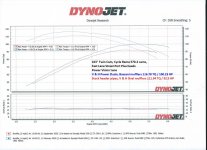Fast Lane
Club Member
Here's a chart from the dyno today that shows the difference between exhaust systems. The build was a 103" Twin Cam, Cycle Rama 570-2 cams set at 10.25:1, my Street Port Plus heads, stock throttle body and injectors and the stock 2007 header pipe (no CAT) with a pair of Vance and Hines oval mufflers. I also did exactly the same build a few months ago, the only difference being the exhaust system. The earlier build had a Vance and Hines Power Duals header system and Bassani Mufflers. We thought it would be interesting to overlay the two charts. There's a difference of 4.84 in torque and 7.73 HP in favour of the Power Duals. Not just the numbers though. You can see how the exhaust influences the position of the peak TQ and HP. The Power Duals and Bassani mufflers bring in the peak TQ 340 RPM earlier and the peak HP occurs 360 RPM later. The build is EXACTLY the same, the only difference being the exhaust systems and the temperature and humidity in the dyno room at the time of tuning. These two builds will feel very different to ride. Never underestimate the influence your exhaust system has!


